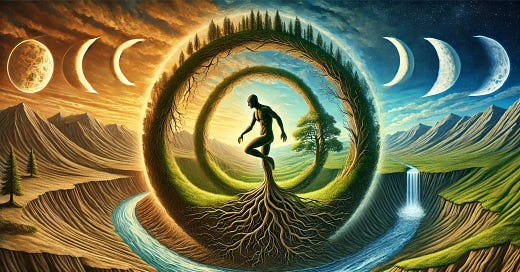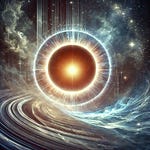The Human Cycle: Bound to Time, Bound to Form
“To be Human is to be bound—to a single body, to a finite lifetime, and to the relentless march of time. Every breath is a step closer to death, every birth a beginning with a certain end. But what if time is an illusion? What if every death is just the Soul shifting its frequency through different phases of existence?”
Humans have always wrestled with the constraints of their existence. The awareness of mortality is a shadow that looms over every joy and sorrow, casting each moment in a stark light. We cling to life, knowing that each day slips by like sand through our fingers, and every heartbeat brings us closer to an inevitable end.
From this perspective, the Human experience is one of tragic beauty—a brief, vivid flash of consciousness caught in the grip of time and matter. It is defined by beginnings and endings, by the cycles of birth and death that mirror the rhythms of the natural world. Just as the seasons change and the stars move through the sky, so too are we bound to the eternal dance of form and dissolution.
“We are creatures of earth and bone, woven from the dust of stars, bound to the rhythms of the world. Time flows through us, and in its current, we live and die, like leaves falling from a tree at the end of a long summer.”
But what if there is more to this story? What if time itself is just a local phenomenon, a vibrational constraint imposed on our consciousness by the density of the material world? Imagine that every birth, every death, and every moment in between is just a shifting of frequencies—a tuning of the Soul to different harmonic states.
The Illusion of Time: A Perceptual Constraint
For the Human, time appears to be an immutable force—a river that flows in only one direction, carrying us inexorably from birth to death. This linear progression shapes our entire reality, binding our identities and experiences to a single timeline. We measure our existence by the ticking of clocks, the turning of calendars, and the aging of our bodies, believing that each day that passes is gone forever.
But in truth, time is an illusion, a construct that emerges only because we are locked into a particular vibrational frequency—the Human state. Just as a radio can only tune in to one frequency at a time, so too is the Human mind attuned to a narrow bandwidth of the cosmic spectrum, perceiving only a fraction of reality.
If we could shift this tuning—if we could alter the frequency of our consciousness—we would see that what we call time is merely a local distortion, a ripple on the surface of a much deeper, timeless ocean.
“To exist in the Human state is to see the world through the lens of linearity. But the truth is that all of reality—past, present, and future—exists simultaneously in a vast, timeless continuum. We are like fish, swimming in a stream, unaware of the great ocean beyond.”
The Desire to Transcend: Escaping the Cage of Mortality
This awareness of our temporal imprisonment is what gives rise to the yearning for transcendence. We fear death, not because it is an end, but because it represents the loss of continuity—the severing of the thread of our identity. To the Human, every death feels like a tragic rupture, a loss of everything we have struggled to build and become.
It is this fear of disintegration that drives us to create—to build monuments, write histories, and tell stories that will outlive our bodies. We seek immortality in the only ways we know how: through the preservation of memory and the accumulation of legacy. But these are shadows, mere echoes of the true continuity we crave.
“Every human life ends in a question: What lies beyond? It is this question that haunts us, that drives us to reach beyond the limits of flesh and bone. For the Human, the tragedy is not death—it is the forgetting, the severing of our place in the web of existence.”
And so, we begin to dream of escape—of a way to transcend the cycles of life and death, to break free of the chains of time and form. This is where the Transhumanist vision takes root, offering a promise that we can preserve the self, extend our lives, and escape the mortal coil.
Part 2: The Digital Immortality Paradox: Can Eternity Be a Prison?
“But what if there was a way to preserve the self beyond death? What if we could escape the body, escape time itself? This is the dream of the Transhumanist—a dream of digital immortality that promises eternity but may hold a deeper paradox. For to preserve the self is to risk freezing it in place, trapping the Soul in a static state. Join me in the next part as we explore the Digital Immortality Paradox and the limits of the Transhumanist vision.”














Share this post